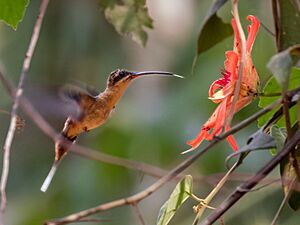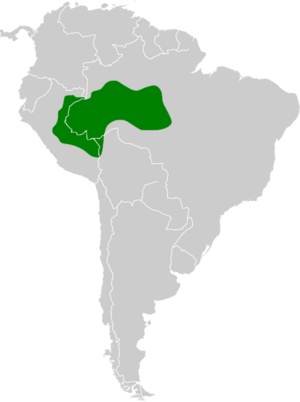Needle-billed hermit facts for kids
Quick facts for kids Needle-billed hermit |
|
|---|---|
 |
|
| Conservation status | |
| Scientific classification | |
| Genus: |
Phaethornis
|
| Species: |
philippii
|
 |
|
The needle-billed hermit (Phaethornis philippii) is a special type of hummingbird. It belongs to the family Trochilidae, which includes all hummingbirds. This tiny bird can be found in parts of Bolivia, Brazil, and Peru in South America.
Contents
About the Needle-Billed Hermit
How Scientists Classify This Bird
The needle-billed hermit is considered monotypic. This means it's the only species in its group, without any different subspecies. Scientists once placed it in a different group called Ametrornis. However, it was later moved into the Phaethornis group, where most hermit hummingbirds are found. The needle-billed hermit is also very closely related to Koepcke's hermit. They are called "sister species" because they share a common ancestor.
What Does It Look Like?
The needle-billed hermit is a small bird, about 12 to 13 centimeters (around 5 inches) long. Male birds weigh about 4 to 6 grams, and females weigh 4 to 5.5 grams. This hummingbird is unique because it has a nearly straight bill, unlike many other hermit hummingbirds whose bills are curved.
Its back and upper parts are a dark, shiny bronze-green color. Its rump, which is the area above its tail, is a dull reddish-brown. The tail is mostly dark green. The two feathers in the very middle of its tail are longer than the others and have long white tips. The other tail feathers have wide, buffy reddish-brown tips.
The bird's face has a black "mask" that looks like it's wearing a bandit's disguise. This mask is outlined by thin, pale stripes. Its belly and chest are a bright orange color.
Where Does It Live?
The needle-billed hermit lives in eastern Peru, northern Bolivia, and western Brazil. You can find it south of the Amazon River, stretching as far east as the Tapajós River.
This hummingbird prefers to live in the lower parts of lowland rainforests. It mostly lives in terra firme forests, which are forests on higher ground that don't flood. However, it can also be found in várzea forests (which flood seasonally), bamboo patches, and even some plantations. It usually lives at elevations no higher than 325 meters (about 1,066 feet) above sea level.
Behavior and Life
How It Finds Food
Like many other hermit hummingbirds, the needle-billed hermit is a "trap-line" feeder. This means it flies a regular route, visiting a series of different flowering plants to drink their nectar. It's like having a favorite snack route! Besides nectar, it also eats small arthropods, which are tiny insects and spiders.
Breeding and Nests
Scientists are still learning about the exact breeding season for the needle-billed hermit. However, it seems they breed at least from June to September. One nest that was found was hanging from the underside of a large leaf tip, keeping the eggs and chicks safe and hidden.
What Does Its Song Sound Like?
The needle-billed hermit's song is described as a continuous series of single, high-pitched "tsee" notes. These notes go slightly upwards in sound.
Conservation Status
The IUCN (International Union for Conservation of Nature) has evaluated the needle-billed hermit. They have listed it as a species of "Least Concern." This means that, for now, its population is not considered to be in danger. We don't know the exact number of these birds or if their population is growing or shrinking. However, they are generally thought to be common in the areas where they live. They also live in some protected areas, which helps keep them safe.


